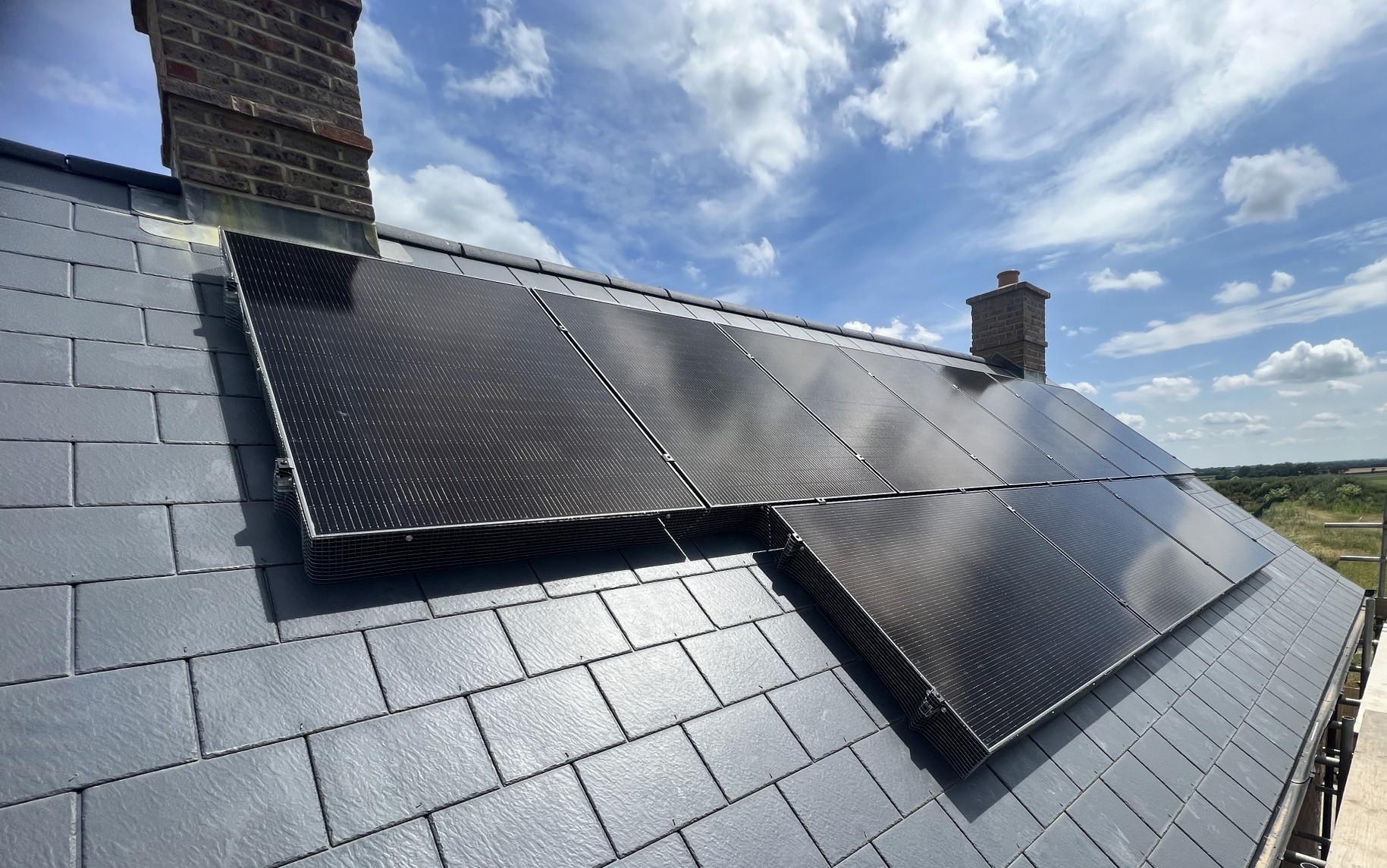A Complete Guide for Homeowners in Essex, Kent, Surrey and the South East
Choosing the right solar panels for your home can feel overwhelming, especially when you discover just how many different types of solar panels are available in the UK. With SolarTherm UK, we make this easier by breaking down each option for you can confidently decide what’s best for your home.
In this guide we’ll explain the nine main types of solar panels including their efficiency, durability, benefits and drawbacks. By the end you’ll know which solar panels suit your roof, budget and energy goals.
What Are the Different Types of Solar Panels?
The most common types of solar panels installed across Essex, Kent and Surrey are monocrystalline and polycrystalline, made from silicon cells. Thanks to advances in solar technology, homeowners now have more choices than ever – nine types in total. Each type varies in price, efficiency, aesthetics and availability.
Here is a simplified overview, which we will go into more detail on later.
| Type of Solar Panel | Efficiency (%) | Lifespan (years) | Available in UK? |
| Monocrystalline | 18–24% | 25–40 | Yes |
| Polycrystalline | 13–16% | 25–30 | Yes |
| Thin film | 7–13% | 10–20 | Yes |
| Transparent | 1–10% | 25–30 | Limited |
| CPV | 35–50% | 25–35 | No |
| PERC | 17–20% | 25–35 | Yes |
| Perovskite | 28.6–33.7% | 25–30 | No (coming soon) |
| Solar tiles | 10–20% | 25–30 | Limited |
| Solar thermal | 70% (heat) | 20–25 | Yes |
Monocrystalline Solar Panels
Monocrystalline solar PV panels are the most popular choice for homes and businesses in the UK. Modern monocrystalline panels have efficiencies between 18 and 24%, lasting a minimum of 25 years with most going on to perform efficiently for up to 40 years.
Monocrystalline panels are made from a single silicon crystal, giving them a sleek black appearance and outstanding performance. They are the most efficient type of solar panel on the market, making them ideal for homes with limited roof space. Monocrystalline panels typically offer the fastest payback period and the highest yearly savings.
Pros
- Highest efficiency of all available on the UK market
- Excellent performance, even in low light and cloudy conditions
- Require fewer panels for the same output
- Sleek black finish makes them aesthetically pleasing
Cons
- Higher upfront cost than polycrystalline panels
- Not ideal for very tight budgets
Polycrystalline Solar Panels
Polycrystalline solar PV panels are an affordable alternative to monocrystalline panels but are less efficient. Polycrystalline panels have an efficiency of between 13 and 16% and last up to 30 years. They are slightly cheaper and more eco-friendly to manufacture as they are made from multiple silicon fragments, giving them a blue mosaic look. Where the efficiency is lower, they require more roof space to produce the same amount of electricity as monocrystalline panels.
Pros
- Lower cost
- More sustainable manufacturing process
- Reliable and widely used
Cons
- Lower efficiency
- Require more panels
- Blue finish that can be less aesthetically pleasing
Thin Film Solar Panels
Thin film solar panels are flexible, lightweight and the cheapest solar panel option. They can be installed on difficult or curved surfaces due to their flexible nature. Thin film solar panels are far less efficient than monocrystalline solar panels at only 7-13% efficiency and with a shorter lifespan of just 10-20 years. While cheaper, they are significantly less efficient, making them less suitable for homes aiming to maximise savings on their energy bills.
Pros
- Flexible – ideal for sheds, garages and caravans
- Lightweight
- Cheapest type of domestic solar panel
Cons
- Poor efficiency
- Short lifespan
- Not ideal for high usage households
Transparent Solar Panels
Transparent solar panels can be applied to glass, enabling solar generation through windows. Currently they are mainly used for commercial buildings and require bespoke design and manufacturing. They have very low efficiencies, ranging from 1-10%, but do last 25-30 years. Due to their bespoke nature, they are expensive and take longer to install.
Pros
- Blend into architecture seamlessly
- Space saving and aesthetic
Cons
- Very low efficiency
- High cost
- Low energy savings
- Slow turnaround times
Concentrator Photovoltaics (CPV)
CPV technology uses mirrors and lenses to concentrate sunlight onto tiny high efficiency solar cells. They have high efficiencies ranging from 35-50%. The technology is mainly used in solar farms in countries with high sunlight levels.
Pros
- Exceptional efficiency
- Excellent performance in intense sun
Cons
- Not designed for residential use
- Very expensive
- Requires active cooling and tracking systems
PERC Solar Panels
PERC (Passivated Emitter and Rear Contact) improves energy capture by reflecting unused light back into the solar cell. Efficiency falls between 17 and 20% on PERC panels, with a lifespan of 25-35 years.
Pros
- Higher efficiency than polycrystalline panels
- Better heat resistance
- Good value for money
Cons
- Being replaced with newer technologies
- Monocrystalline panels are still more efficient
- Slight more expensive than monocrystalline panels
Perovskite Solar Panels
Perovskite solar panels are a new technology and are widely expected to transform the global solar market with record breaking efficiency and lower manufacturing costs. With efficiencies expected between 28.6 and 33.7%, they will have the highest efficiency on the market. They are predicted to become widely available for sale for commercial properties in 2026, with residential use coming soon after.
Pros
- Highest efficiency potential of any panel
- Same size as standard panels
- Future proof investment
Cons
- Not yet available
- Likely to be expensive, at least at first
Solar Roof Tiles
Solar tiles replace traditional roof tiles and can generate electricity. They are ideal for properties within conservation areas or with listed building status as they provide a integrated look that doesn’t interfere with the aesthetic of the property. Solar tiles are a newer technology on the market with limited options available in the UK. Their efficiency ranges from 10-20% and have a lifespan of 25-30 years.
Pros
- Seamlessly integrated into your roof
- Long lifespan
- Great for listed or protected buildings
Cons
- More expensive than panels
- Lower efficiency
- Requires a full roof replacement
Solar Thermal Panels
Solar thermal panels use sunlight to heat your hot water rather than to generate electricity. They significantly reduce water heating costs and pair well with combi boilers, heat pumps and immersion heaters. They show 70% efficiency at converting sunlight into heat and last 20-25 years.
Pros
- Cuts hot water bills by up to 50%
- Highly efficient
- Ideal for homes with high water usage
Cons
- Do not generate electricity
- Cannot provide 100% of your hot water year round
- Being replaced with newer technology like solar PV panels and solar diverters which are more efficient.
Which Type of Solar Panel is Best for Your Home?
Choosing the right solar panel depends on your roof size, budget, electricity usage and future energy needs. At SolarTherm UK, we mainly install monocrystalline solar PV panels. These give the highest efficiency, best savings and are ideal for the majority of homes and businesses across the South East.
If you are looking for an integrated solar PV system, there are a number of options available. To avoid the higher costs and delivery delays of solar tiles, you could opt to have an integrated solar PV system installed. This replaces your traditional roof tiles with in-roof solar panels. While solar tiles are the perfect choice for those looking for a fully integrated look, solar tiles are only available through two suppliers in the UK with long waiting times for delivery of the tiles, which could cost your hundreds of pounds in savings while waiting for them to be manufactured and installed.
If you are looking for a solution to high hot water costs, then solar thermal panels would be best for your property. Although at SolarTherm UK we would recommend installing monocrystalline solar PV panels and a solar diverter, allowing you to reduce both your hot water bills and your electricity bill simultaneously.
What’s Next for Solar Technology?
Solar scientists are always researching the next development in solar technology, and while still several years away from making it onto the solar market, Quantum Dot solar panels and Zombie solar panels are showing potential as the next innovations. Quantum dot solar panels are expected to reach efficiencies up to 66% using nano-sized semiconductors that will capture a wider spectrum of light. Zombie solar panels are showing potential for use in low light and indoor environments. Their cells operate differently from traditional solar cells and will operate efficiently even when the electrolytes have dried out.
Ready to Start Your Solar Journey?
SolarTherm UK has been helping homeowners and businesses across Essex, Kent, Surrey and the wider South East, save money on their energy bills with green energy solutions for over 15 years.
Contact SolarTherm UK for a free, no obligation quote and design, tailored to your property, usage and future energy needs. No hard sell, just honest, expert advice.
Your home. Your energy. Your future.
FAQs
What type of solar panels are best for UK homes?
Monocrystalline solar panels are currently the best option due to their high efficiency, durability, and excellent performance in cloudy or cool UK weather.
What are the most common types of solar panels?
Monocrystalline and polycrystalline panels are the most widely installed options across the UK.
Are monocrystalline panels better than polycrystalline?
Yes. Monocrystalline panels are more efficient, produce more power per square metre, and offer better long-term value.
What type of solar panel lasts the longest?
Monocrystalline panels typically have the longest lifespan—up to 40 years.
Which solar panels work best in low light?
Monocrystalline and PERC solar panels outperform other panel types in cloudy or winter conditions.
Can solar tiles replace traditional solar panels?
Yes, but they are more expensive and less efficient. They’re best suited for aesthetic or conservation requirements.





